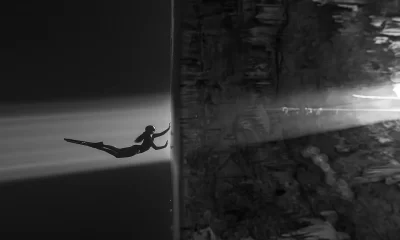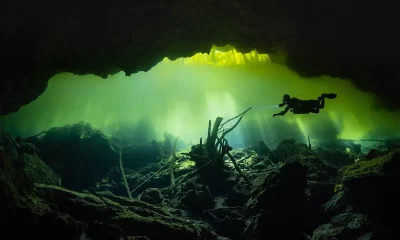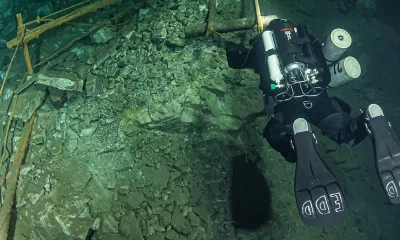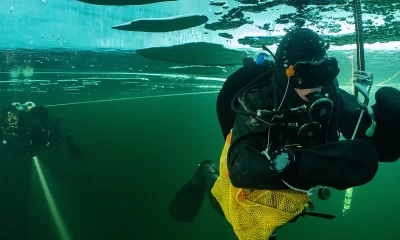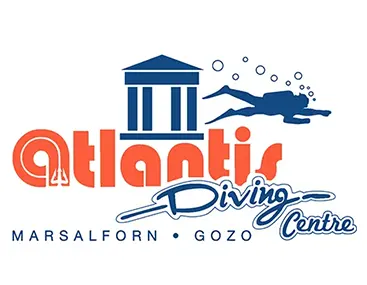Conservation
Exploring Whale Culture with Nat Geo Photojournalist Brian Skerry
The tech diving community tends to equate exploration with surveying virgin cave passage and/or discovering a shipwreck that was heretofore out of reach or out of mind. In this interview Rolex NATGEO Explorer of the Year, Brian Skerry, discusses his three-year project exploring the arcane life and culture of whales, and exactly what it took to bring home the data.
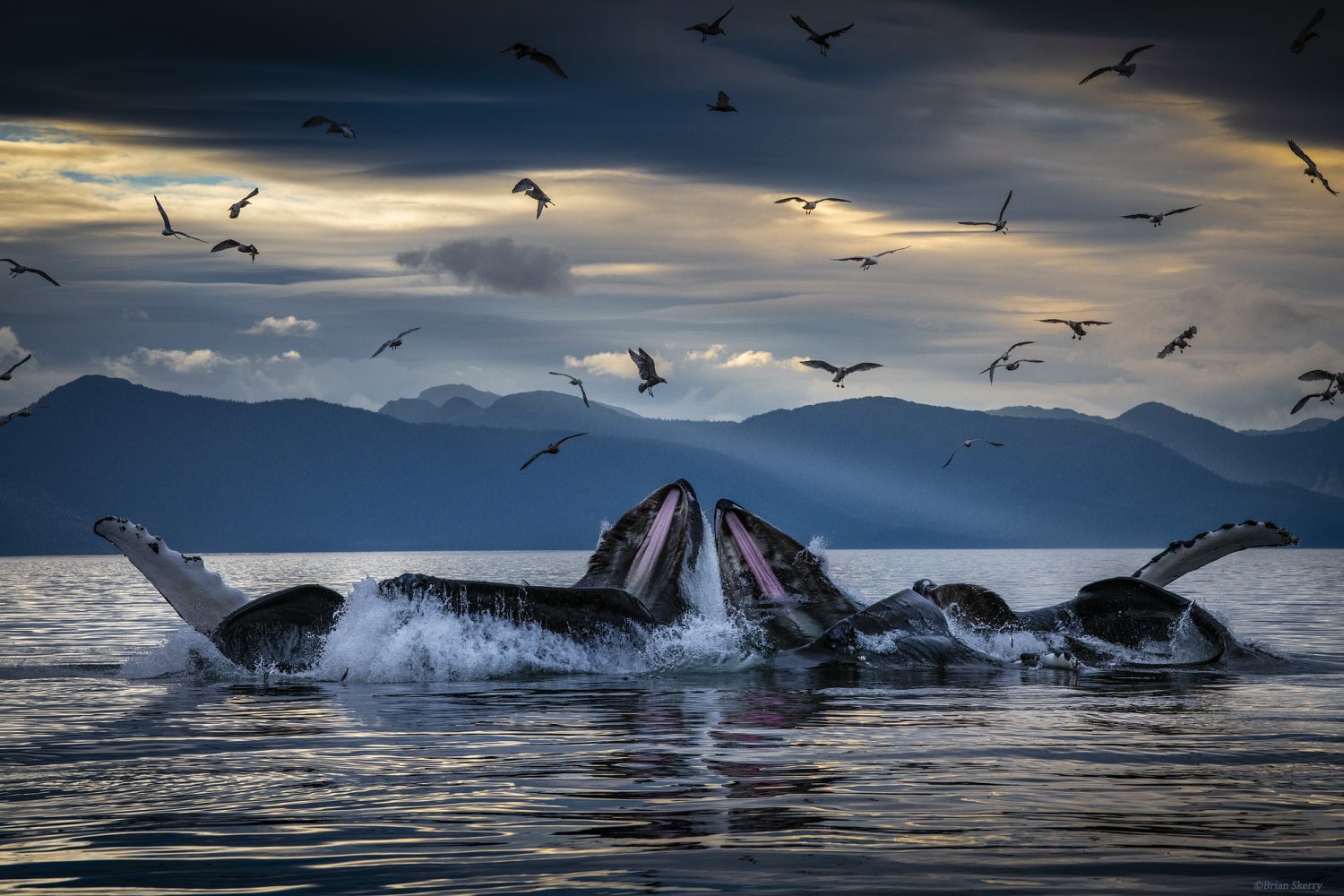
By Michael Menduno
Header image: Humpback whales bubble-net feeding in the waters off of Alaska (see explanation at the end of the story for more detail). Header image and photos courtesy of Brian Skerry unless otherwise noted.
Companion stories: W I L D Life
Can We Learn To Talk With Whales?
Listen to sperm whales talking (SoundCloud)
fifty-nine year old photojournalist, explorer and storyteller Brian J. Skerry is arguably one of our most prolific ambassadors to planet Ocean. His latest work, Secrets of Whales; a book, a four-part Disney+ documentary with Executive Producer James Cameron, and narrator Sigourney Weaver, that has been nominated for three Emmys, and a National Geographic cover story—the result of three-years in the field—has easily already reached more than 100 million people around the world. Most importantly, his work is profoundly changing how we view and understand these highly intelligent, big-brained mammals that we share the planet with.
Meanwhile, his acclaimed exhibit, “SHARKS: On Assignment with Brian Skerry” at the National Geographic Museum, which opened this summer in Madrid Spain, an extension of his 2017 book SHARK, is helping to create awareness of the plight of sharks around the world. Unfortunately more than 100 million are killed each year, primarily for their fins.
Skerry has been a contract photographer for National Geographic since 1998 beginning with shipwrecks and becoming one of their foremost marine wildlife photographers. He is now working on his 30th Geographic story. In 2014, Skerry was one of five photographers named as a NatGeo Photography Fellow. Two years later, he was awarded Geographic’s Photographer’s Photographer Award—an award that the hundred or so National Geographic photographers vote on each year to honor the photographer who inspired them the most. He was named a Storytelling Fellow in 2017, and that same year, was awarded the title, Rolex National Geographic Explorer of the Year. Clearly, this hard working photo-maker is at the top of his game.
Skerry’s work has been featured in publications such as Sports Illustrated, The New York Times, BBC Wildlife, Paris Match, GEO, The Washington Post, The Wall Street Journal, Smithsonian, Esquire, Audubon and Men’s Journal. He has lectured on photography and marine conservation at the United Nations General Assembly, The World Economic Forum in Davos, Switzerland, TED Talks, The National Press Club in Washington, DC, The Royal Geographical Society in London and the Sydney Opera House in Australia
He is the author of 12 books including the acclaimed monographs Ocean Soul and SHARK. He is also an 11-time award winner in the prestigious Wildlife Photographer of the Year competition. In 2010 National Geographic magazine named one of his images among their 50 Greatest Photographs Of All Time. Heady stuff for the soft spoken explorer who grew up in a working-class, textile mill town in Massachusetts, an hour from the ocean, with a dream of becoming a Nat Geo photographer.
I met Brian in the early 1990s when he was coming up as a shipwreck diver and photographer, working at a corporate day job, and taking underwater photos on the side. I enlisted him as a field editor for my magazine aquaCORPS Journal and we published some of his work in the magazine (See: “Steel Fish” below). He also helped out as a presenter and MC at aquaCORPS’ early tek.Conferences. I had the opportunity to speak with Brian about Secrets of Whales and whale culture over the summer. Here is what he had to say.
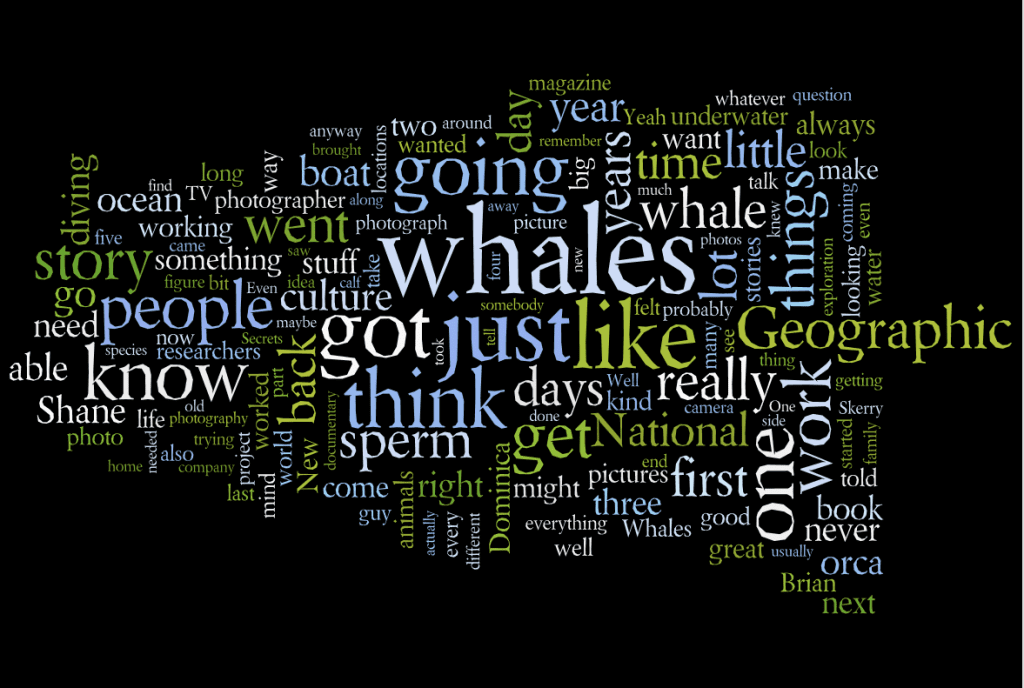
Michael Menduno: In the technical diving community, people think of exploration as finding new caves and or passage or discovering a heretofore lost shipwreck. But it struck me, when I heard your talk, that your recent work on whales is exploration in its truest sense. And I was reminded of Bill Stone’s observation regarding the difference between exploration and adventure—bringing home data. You’re coming back with gigabytes of image and video data. You are an explorer sir.
Brian Skerry: That’s a perfect analogy, Mike.
Do you see yourself as an explorer with a camera? Or a photographer with a penchant for exploration, or both?
Ha! Well, a little of both I guess.
When people ask me how I got started, I usually describe falling in love with the ocean as a little boy growing up in Massachusetts, wanting to be an ocean explorer. I was watching the old Cousteau shows and reading National Geographic. So, my initial desire was to just explore the ocean. To explore and swim with sharks and whales and dolphins and shipwrecks and do cool things.
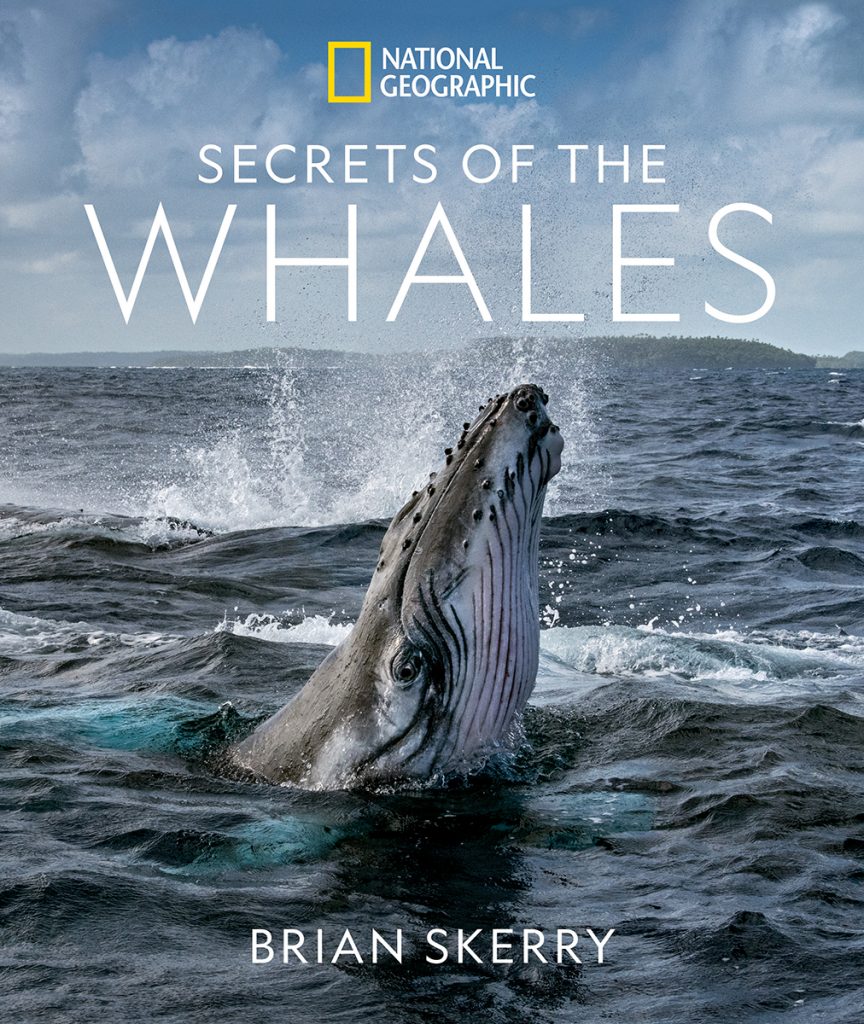
I started scuba diving at age 15, and it was maybe a year or two after that that I attended my first Boston Sea Rovers show. I remember sitting in that audience as a teenager and watching photographers and filmmakers present their work. I often describe it as an epiphany. I had always been inspired looking at underwater photos, and I never really thought about the people making them.
But then I had this moment of clarity where I said, “That’s how I want to explore the ocean.” I was always a visual person. I loved books, magazines, and movies. And the idea of having a camera in my hand and swimming around making pictures of things that I was learning about, and then sharing that with others, really appealed to me. Of course, I came from this little, working-class town, I didn’t know how to do that then, and I had to figure it all out. And now, 43 years later, I’m still constantly searching for new ways to explore.
I can really relate to that desire to share what I am learning or discovering with others. Sharing stories.
I think of myself as a storyteller, like you. I am always trying to find meaningful ways to engage audiences about our planet. Over the years, a lot of my work has evolved into conservation because I was seeing all these problems in the ocean that I didn’t think were evident to most people. I knew I had a unique opportunity to reach a big platform. Ultimately, I believe that people protect what they love and that we need to find new ways to get their attention, get them to care.
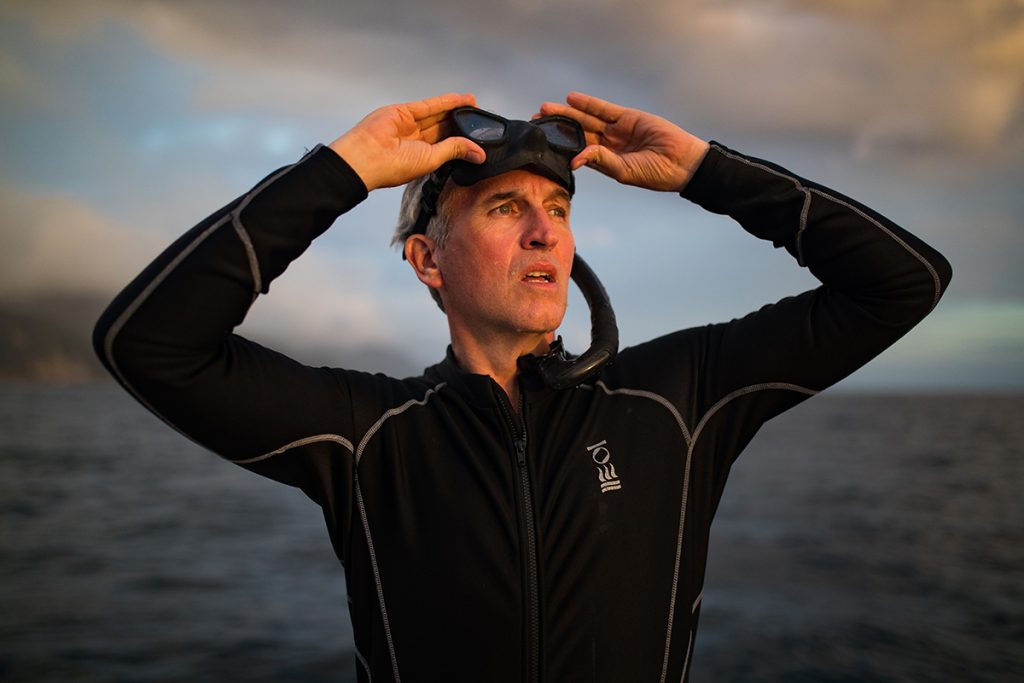
So, anyway, a very long answer to your question: Yes, I do see it as exploration. At the end of the day, I see myself as somebody who parachutes into the life of researchers who dedicate their lives to this stuff and who brings visuals to what they do.
I want to talk with you about your field work and collaborating with researchers. But before we do, I was hoping you would explain a little about the National Geographic universe, how you got there and your role there. When we first met in the early 90s you were an industrial sales rep who wanted to become an underwater photographer.
I absolutely did. You can appreciate this more than anyone because you knew me in those early days when I was trying to stake a claim out there. Again, I go back to my rather humble beginnings. I came from this little working-class, textile mill town in Massachusetts. I was about an hour away from the ocean. So, my parents would take me to the beaches in the summertime, but other than that, I was growing up in a little landlocked mill town. My family worked in manufacturing—that’s what they did. My mother never flew on an airplane in her entire life. My parents grew up in the depression. My father served in World War II. He fought in Italy and Africa and North Africa and Germany and then came back home, got a job in a textile mill, met my mom, and they built the American dream. I grew up working in those mills after football practice in high school.
So, my big dream of being an ocean explorer was just about as foreign to my culture as you could imagine. And the notion of wanting to be a National Geographic photographer—which was always my goal from the very beginning—it would have seemed easier to climb Mount Everest.
Back then, there were three photographers who were doing underwater stories for National Geographic. They were well-established and the best in the business. Looking back, this made my dream of becoming a National Geographic underwater photographer seem even more unlikely. But when you’re young and passionate, you don’t necessarily think about such things.
You studied photography in college, right?
Yes, I went to Worcester State college and graduated magna cum laude with a degree in Communications/Media. I studied photography, photojournalism, television production and film. But when I graduated, I couldn’t just hang a sign on the door to say I was an underwater photographer. I had to go to work. I worked in a corrugated box factory on the second shift. Then, after several months working in the factory, I got a job in the office doing sales. It paid the bills and allowed me to buy underwater cameras and equipment so that I could continue honing my photography skills and working toward my dream.
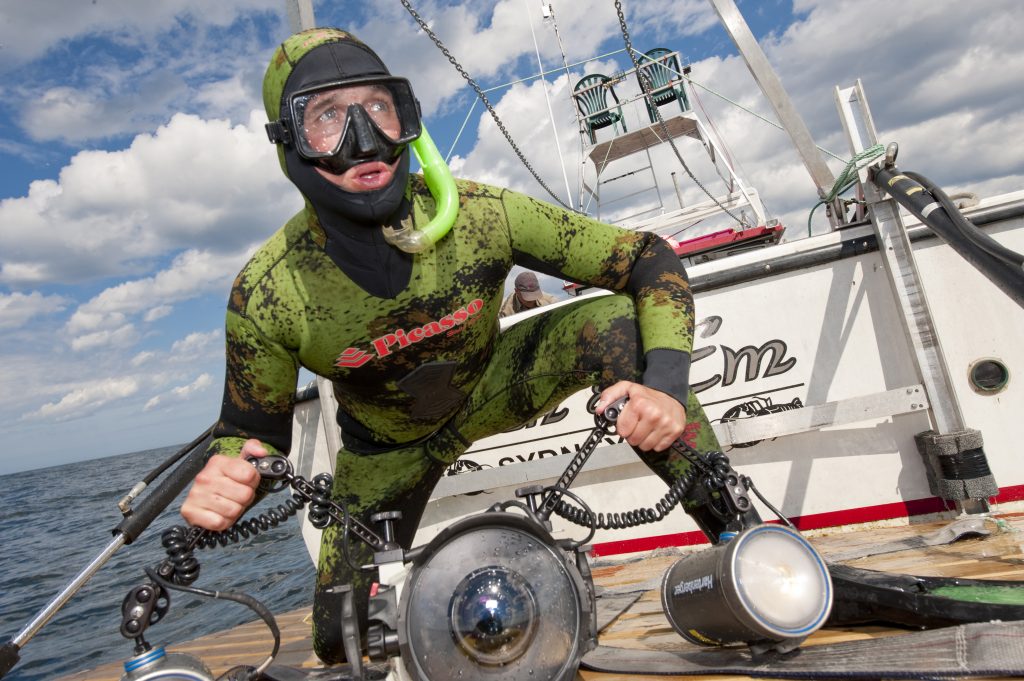
At the time you were doing photography as an avocation, and you were a field editor for my old magazine aquaCORPS and shooting pictures for us.
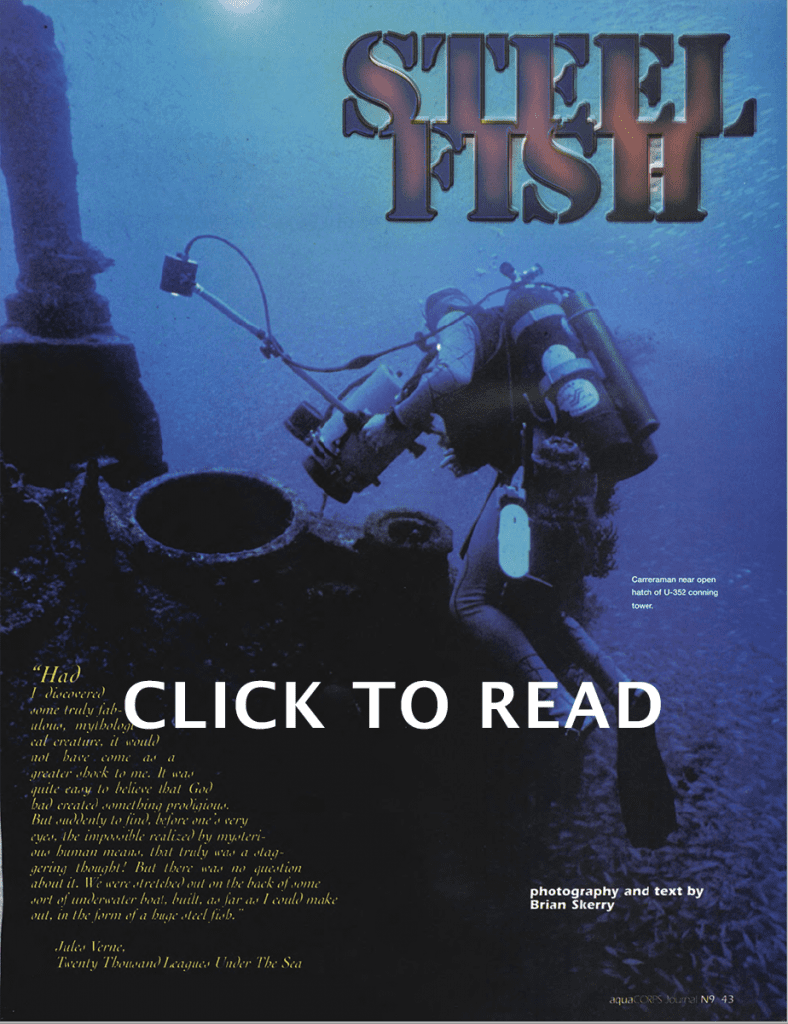
From the time I bought my first camera at 17 years old, I was always trying to figure out how to build a photo business. I didn’t know how to do it; nobody gave me any advice. I had no mentors really to speak of until much later. I started with diving magazine assignments. So, I was doing work for you at aquaCORPS, as well as Discover Diving magazine, Skin Diver, and Sport Diver. Then I started getting assignments that had underwater themes for other magazines like Snow Country where I photographed the Olympic ski team training in a pool with a physical therapist.
I also did speaking engagements and wrote books. My first book was in 1995, Complete Wreck Diving with Hank Keatts, which was published by Water Sport Publishing. Five years later, I wrote my first natural history book, “A Whale on her Own.” It was a children’s book about an orphaned beluga whale that was living in Nova Scotia.
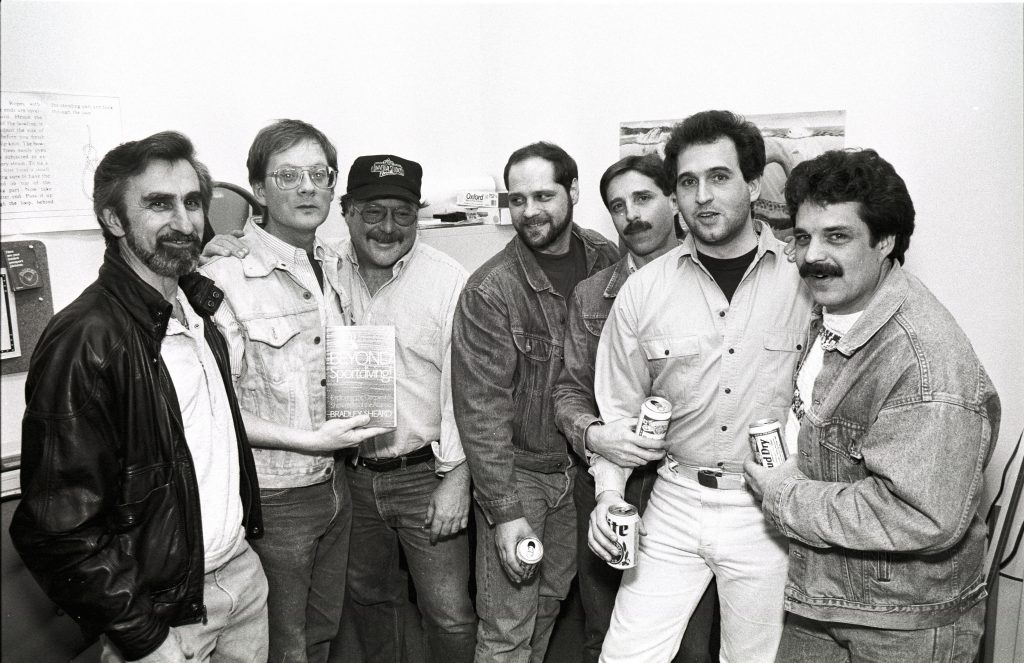
In those early days, I was gaining dive experience and photo experience by working on charter boats and doing shipwreck photography. I worked for 10 years on a dive charter boat out of Rhode Island. I did a dozen dives on the Andrea Doria and I was one of the first to dive with Gary Gentile on the USS Monitor.
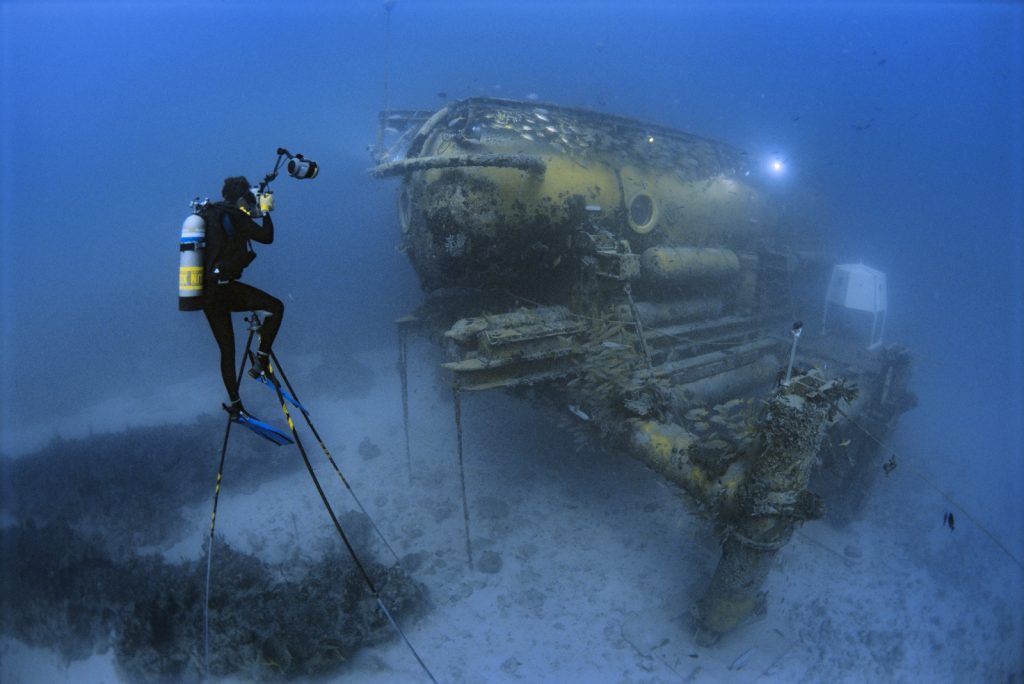
You did your first assignment for Nat Geo in 1998. How did you pull that off?
My entrée into National Geographic was as a shipwreck photographer. Geographic had actually published a couple of my photos that I had randomly submitted; one was a Doria photo, on the anniversary of the Andrea Doria’s sinking, that ran in their front matter of the magazine. The other was a rare fish that I photographed in the Bahamas.
So, one day I got a call from Bill Curtsinger, whom I became friends with later in his career. He told me that he had two assignments for National Geographic—one that he wanted to do and one that he didn’t. The one that he didn’t want to do was a pirate shipwreck, the Whydah Gally, lying in shallow water off Cape Cod. He said the visibility was horrible, there was some kind of weed everywhere and the wreck was buried under 30 feet of sand. Basically, there was nothing to see. He offered to recommend me for the assignment but warned that you only get one chance with National Geographic, and he felt I had about a 98% chance of failure.
I thought about it but was confident. Cape Cod was in my backyard, I knew wrecks, I had been diving in poor visibility for years, and I felt I could tell that story. So, with Bill’s referral, they looked at my work and gave me the assignment. Everything he said was true, but I figured out ways.
We were finding treasure—Spanish coins and artifacts and sections of the hull. I decided to use negative film instead of slide film, because it gave me more latitude.
I had been given these 1000-watt Birns & Sawyer snooper lights with cables by Peter Gimbel’s widow after he died. He had used them on the Doria years ago when he did his TV specials. I used them to eliminate backscatter. Anyway, I made pictures that they liked and now, 23 years later, I’m working on my 30th story for the magazine. I transitioned from shipwreck photography into wildlife and natural history conservation photography subsequent to the Whydah assignment.
What motivated you to make that transition from shipwrecks to wildlife and conservation?
I was always fascinated by wildlife and dreamed of working with animals like sharks, whales, and dolphins. In some ways I think that I believed (and still do) that natural history stories were where I could create the most meaningful stories. Using science to better understand our planet and our relationship with everything around us. I’ve come to realize that everything is connected and that our actions matter.
So, you began working with Geographic. Were most of them assignments, like the Whydah story?
Actually, since that first assignment, almost every story that I’ve done for Geographic has been my idea. I’ve researched it and proposed it.
So you have basically been able to steer your work to the stories that were compelling to you!
That’s right. I’ve been able to choose the stories I want to tell based on what interests me and what I feel is important to talk about. My dream was never to photograph dead sharks or dead coral, but I felt that these were important things to document. And I was given this unique privilege, a blessing to be able to go out and reach 50 million people a month in the magazine. And now, with social media, even more.
And I’ve got kids. I care about the planet and the future.
Do you have a favorite story or stories that you have done for Nat Geo?
That’s a tough one. I’ve enjoyed working on every story that I have done for the magazine, but there are some truly special moments that stand out. My first cover story about the Harp seal in 2004 was an amazing experience. And I did a cover story in early 2017 about saving America’s oceans. The 2016 National Park Service Centennial year gave me the idea to look at the ocean over the next centennial, highlighting the importance of Marine Protected Areas (MPAs). While working on this story, President Obama added 850,000 square miles of ocean to protected waters off Midway island. I had the privilege of being invited to snorkel with him in these waters and made the first pictures of a US president underwater. It was fantastic!
Of course, my latest work on whale culture has also been a highlight of my career.
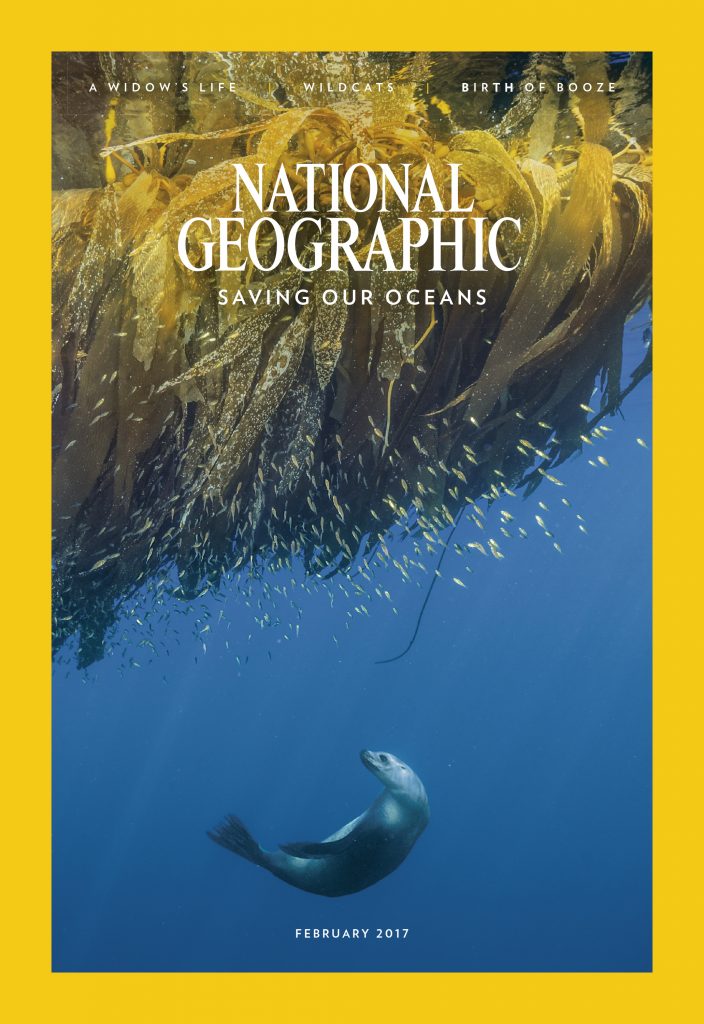
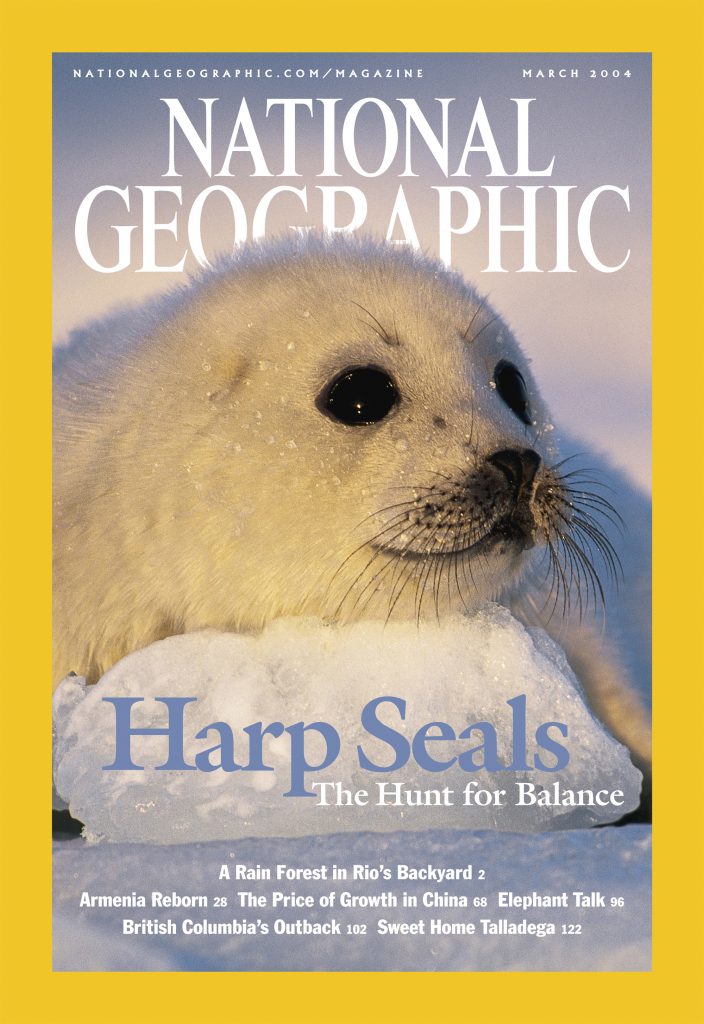
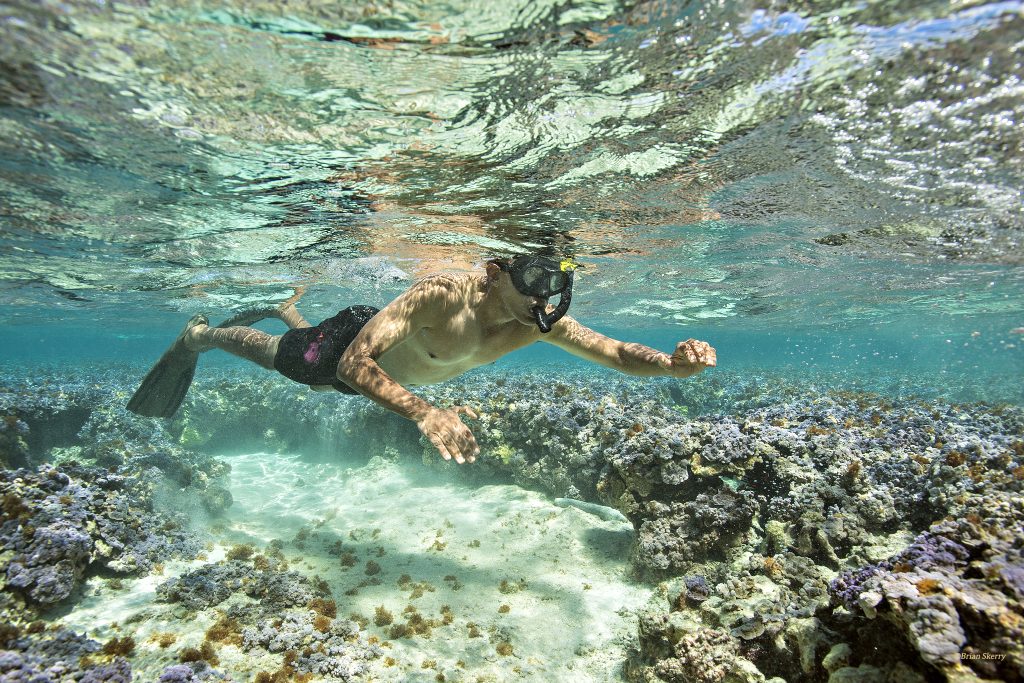
It’s just awesome work Brian. And I’m amazed and thrilled by how much publicity your whale book and documentary is receiving. OMG. Mr ocean Ambassador! I’ve seen you on multiple TV interviews including with Anderson Cooper, and the Today Show. Wow. You also have SHARKS—a NatGeo shark photo exhibition that recently opened in Madrid going on, and that’s getting press, too. Your work is literally reaching millions.
Yeah. I’m really thrilled that Secrets of the Whales is reaching so many people thanks to National Geographic and Disney. And because there really seems to be an appetite for a story like this. The research being done today is revealing cultural aspects of these animals that are really a game-changer going forward. Once we understand the complex societies and cultural traditions of these animals, we start to see how, in many ways, they are like us, and I hope this will make people want to protect them and the oceans.
With the shark story, my goal was to give sharks a makeover. I wanted to look at what are considered the four most dangerous species of sharks and show their beauty while highlighting some of the dangers they face because of human activity. This work became four separate stories in the magazine and a book, as well as a traveling exhibit worldwide.
Let’s talk about whales. Was the idea of whale culture a hypothesis that you started with and sought to document, or did you arrive at it as a conclusion of your work?
The whole proposal in creating Secrets of the Whales was based on legitimate science that had been published by dyed-in-the-wool researchers. There’s a book on my bookshelf called, The Cultural Lives of Dolphins and Whales. It was written by doctor Hal Whitehead, a Canadian researcher who spent his life studying sperm whales. He’s been on his sailboat all over the world. Back in the day, he would travel many months a year in the Galapagos or Sri Lanka, or wherever, following sperm whales.
His student, Dr. Shane Gero, has been studying sperm whale populations in Dominica for 16 years. It was really Shane who helped me formulate this whole project in the very beginning. He wrote an op-ed for the New York Times a few years ago. It was called “The Loss of Whale Culture.” And in that op-ed, he basically laid out an argument for protecting certain populations of whales. In many ways, this whale project was the continuation of my 2015 NGM cover story about dolphin cognition.
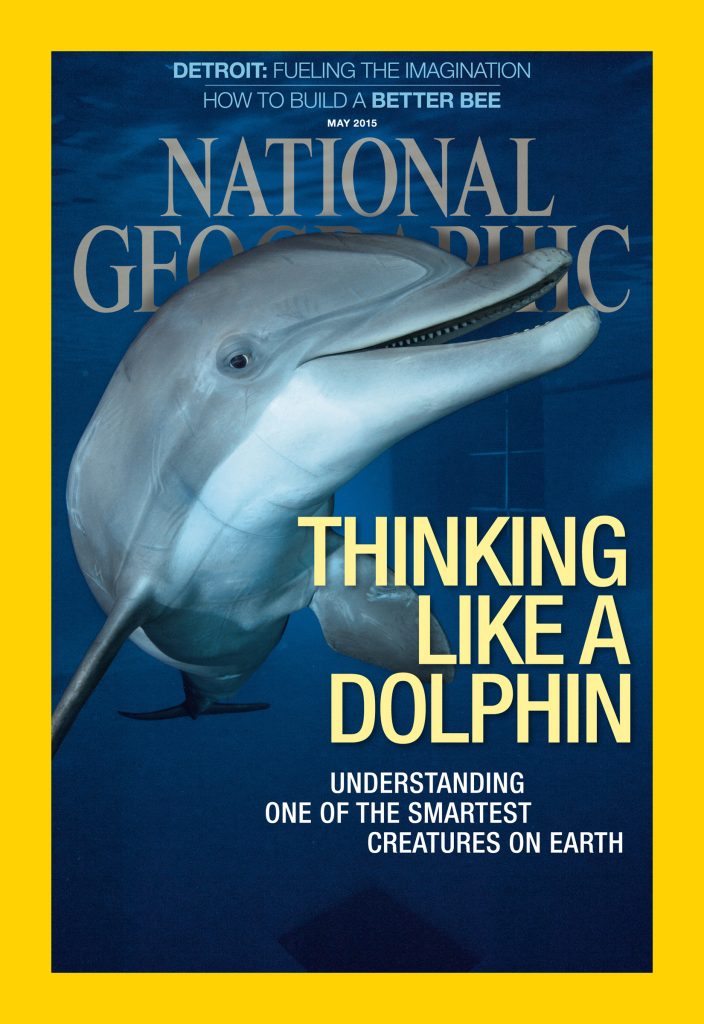
What was his premise?
Shane has been studying in Dominica, and he’s identified maybe two dozen family units. A family unit of sperm whales might comprise 6 to 15 whales. But the two dozen families all speak the same dialect, or codas [See: Project CETI]. He said that that makes them a clan; it is their culture. Other genetically identical sperm whales that move into those waters speak a different dialect—there is no intermingling.
When he told me this, my mind immediately went to the neighborhoods of New York at the turn of the 20th century where you had the Irish and the Italians and all these little enclaves of language. Really fascinating. It’s also interesting that whales don’t go to war and they don’t have any conflicts, as far as we know. They just kind of keep to themselves. As he explained all of this to me, I extrapolated, and decided to look at humpback whale research. I saw that there were scientific papers about their songs, which have been described as the horizontal transmission of culture.
Then I looked at orca research and learned about their feeding strategies and how this varies, depending on where they are in the world. For example, the orca that live in New Zealand have a preference for stingrays. The ones in Patagonia like sea lion pups. They are identical animals, like humans, but they’re doing things differently in different parts of the world based on what they were taught by their ancestors; traditions that have been handed down through generations.
In his article in the Times, Shane said that the sperm whales in Dominica, are on an annual downward trajectory of an annual 3% decline due to anthropogenic stresses. They get entangled in fishing gear, they get hit by ships and so forth. He said that historically, scientists would look at that and say, well, eventually we’re going to lose that population. And as bad as that is, it’s not the end of the world because other sperm whales will come in and fill that niche. But Shane’s argument is that what the Dominica whales know is unique to their culture. There were sperm whales in Dominica before humans walked upright. And what they know about their culture, the location of canyons and seamounts, where to find food and how to do things, is unique to them. Therefore, we need to preserve whale culture. This really made me think. When we look at the animal kingdom, what do we do? We do population stock assessments. We say there are a million blue jays in the world or there are 360 North Atlantic Right whales left. But within those populations, are there unique cultures?
I never thought of it that way!
Certainly, within the world of primates, we know that’s true. And whales and dolphins absolutely have culture involving everything from feeding strategies to dialects to parenting techniques at a micro level. When a mother sperm whale has a calf in Dominica, she finds a babysitter when she has to dive down 600 meters (1958 feet) foraging for squid. Some families have a dedicated female babysitter. In others, they take turns. And in others, they even have wet nurses that can nurse the calf. So, again, even at a micro level, identical species of whales are doing things differently.
Like humans—I know scientists hate to anthropomorphize creatures—whales in different geographies have distinct cultures!
In many respects, I think we are just at the infancy of understanding animal culture. If we survive as a species, I think it’s going to be one of the frontiers of exploration. During the last year that I was working on Secrets of the Whales, I had the pleasure of spending time with Dr. David Gruber from the University of New York. He became enamored with sperm whales and wanted to understand more about them. He ultimately determined that he wanted to put his efforts into cracking the code of their language. He wants to be able to talk to sperm whales.
Project CETI!
Yes, Project CETI. David got a grant from the TED Audacious project and from National Geographic. He now has a project in the works with Shane and a cast of many to try to figure this out. It’s really cutting-edge exploration.
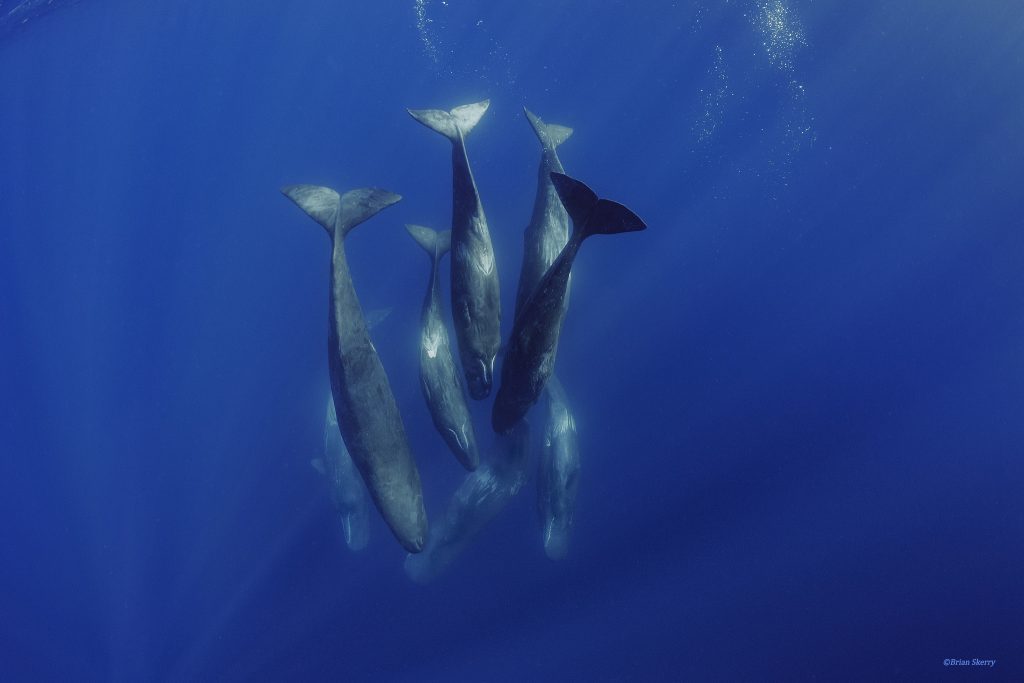
Dr. Gruber was kind enough to supply us with some details about the project, which we have in the issue, “Can We Learn To Talk With Whales?” That would take things to a whole other level.
That’s right. Whatever else people do in terms of exploration, whether it’s caves or wrecks or thermal vents or whatever, everything is part of that bigger equation. They all factor in some way. But we share this planet with so many other species. And for us, for so long, we’ve seen ourselves as above or apart from nature, when in fact we are intimately connected to it. And I think the more that we understand this, the better our chances are for survival.
“And for us, for so long, we’ve seen ourselves as above or apart from nature, when in fact we are intimately connected to it. And I think the more that we understand this, the better our chances are for survival.”
Which is arguably at issue these days!
Yes, it’s dubious at the moment, right?
I would say yes! Let’s get down in the weeds, err, the seaweed a bit, and talk about your work as an ocean photojournalist. I’m guessing that most people have no idea what your work life is actually like. What would you say is the biggest thing that people don’t understand about your work?
Really great question. I would say, probably the first thing that comes to mind is the amount of work and dedication that it requires. Not long ago in an interview, somebody asked me, what do I like to do on vacation? And it occurred to me that I haven’t had a vacation since 1993. My wife, Marcia, and I went hiking in the Grand Canyon. She wanted to take me somewhere where there was no ocean because otherwise, I’d be distracted.
But there’s a back story.
Do tell!
In 1993, I was wreck diving in the Outer Banks of North Carolina. I made dives on the U-701 and the Diamond Shoals Lightship, which was in about 200 feet (61 m) of water. I was diving it on air. It was the early 90s—the aquaCORPS days—and I was doing a lot of deep wreck diving at that time.
The long and short of it—I got bent. I took a hit in my right shoulder, which I had strained during a dive on the Lightship. My next scheduled dive trip was a month away, and I decided to take some time off. So, we went to the Grand Canyon. And that was my last vacation.
But getting back to your question, I think there are a couple of things that most people wouldn’t know about being a National Geographic photographer. I think a common misconception is that a National Geographic photographer is assigned stories. That can happen, but in most cases, especially in mine, you have to come up with the idea. You have to create the story. There’s a whole lot of time and research that goes into creating a story. You have to figure out what the story is by reading and talking to scientists, researchers, charter boat captains, and local divers. Then you have to figure out if you can get the visuals to go along with the story. Where is the best place or places to go in terms of access, reliability, and visibility? When is the best time to go? Then, of course, you have to figure out all the logistics of how to get there and what you need for a budget. I might spend a year just figuring this all out before I can write a proposal.
Another misconception is that when National Geographic approves a story, there is a massive team of people doing all the stuff for you. The truth is, if they approve a story and the budget, you have to go do it. I’m booking my own flights, hiring assistants, chartering boats, figuring out how many days I need to be in each place. No one is doing that for me and it is very, very time-consuming.
I truthfully work seven days a week, 365 days a year. I don’t remember a day when I wasn’t answering emails, researching stories, writing proposals, figuring out logistics, organizing photos, working on gear, or something.
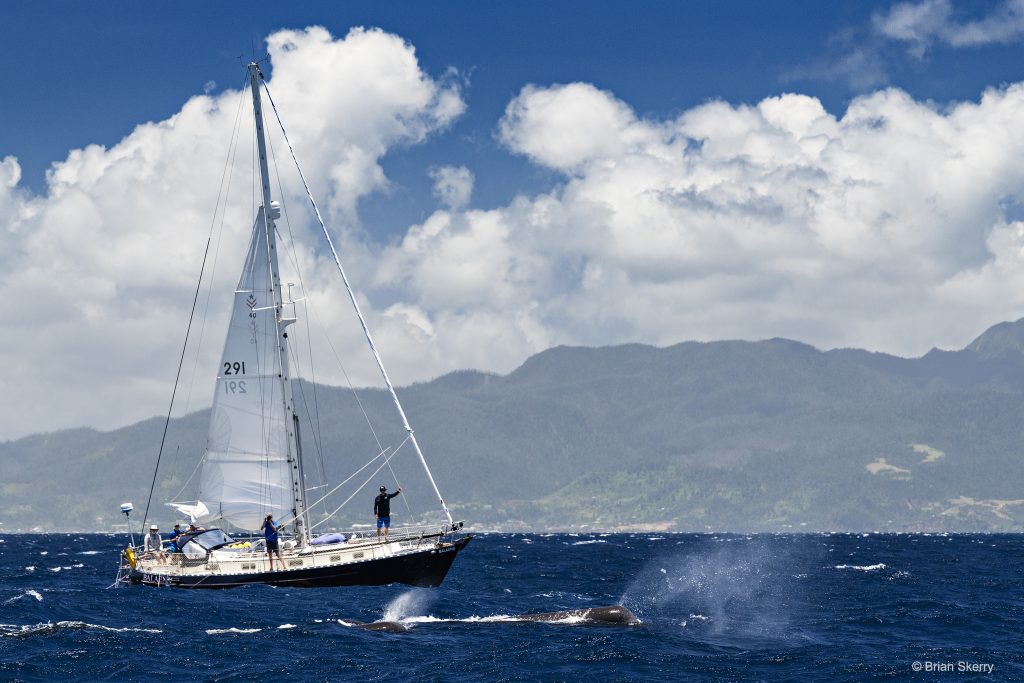
But I know how fortunate I am to be doing what I love. I’ve been doing this for a very long time and it’s been great. I have no complaints.
Ha! That’s great. A labor of love! Yes, maybe you can dispel some myths here. A bit of a reality check!
Right.
In one of your TV interviews, you mentioned that you made 24 trips as part of the whale project over the last three years. Talk to me about that. Did you start out and say we need to be in these locations? Did you organize it yourself? How did that come about?
It had probably been a decade or more since my last whale story, and I wanted to do another about multiple species. But I wasn’t sure what the story would be. I really got focused when I talked to Shane, and in 2016, I dove deep (no pun intended) into the research and the logistics of what it would take to produce a story like this so that I could write a proposal to National Geographic.
When I write a proposal for the Geographic, I need to be able to give a general idea of what the story is about, why it’s relevant, and why it matters to readers. I’m competing against a lot of other writers and photographers who are pitching stories. I also need to address what can be done visually. I always build that component into my proposals.
I should also just back up and say that when I created this project, it was first approved as a magazine story. Then, given the scope and scale of what I wanted to do, I applied for a fellowship grant through the National Geographic Society. Then I went to Nat Geo TV, and I pitched the idea of doing a documentary, which turned into a four-part series. Of course, it also became a book.
You hit all the different platforms.
Again, as a storyteller, if you can get it out on multiple platforms, you’re going to reach a broader audience.
And get your message out. I get it. The fellowship enabled and supported you to do these things?
Yes. To tell the story I had proposed would require shooting in at least 12-15 locations worldwide in order to photograph the main species I wanted to cover, sperm whales, humpbacks, beluga and orca. When the TV division agreed to do the documentary series, they brought in a production company, under a separate budget, allowing us to expand locations.
So how do you go about making pictures of whale culture? What was your original thinking?
I knew that culture was going to be hard to photograph. I remember having lunch with the director of photography at the time, in the cafeteria at National Geographic. She asked that very question when I floated the idea of whale culture. I realized that the writing would have to do a lot of the heavy- lifting, but I also knew that I could make compelling images. I could photograph mom and calf pairings, socializing behavior, feeding strategies. I had really teased out all the locations, who to work with, what time of year, what boats to use, and what behavior I might see.
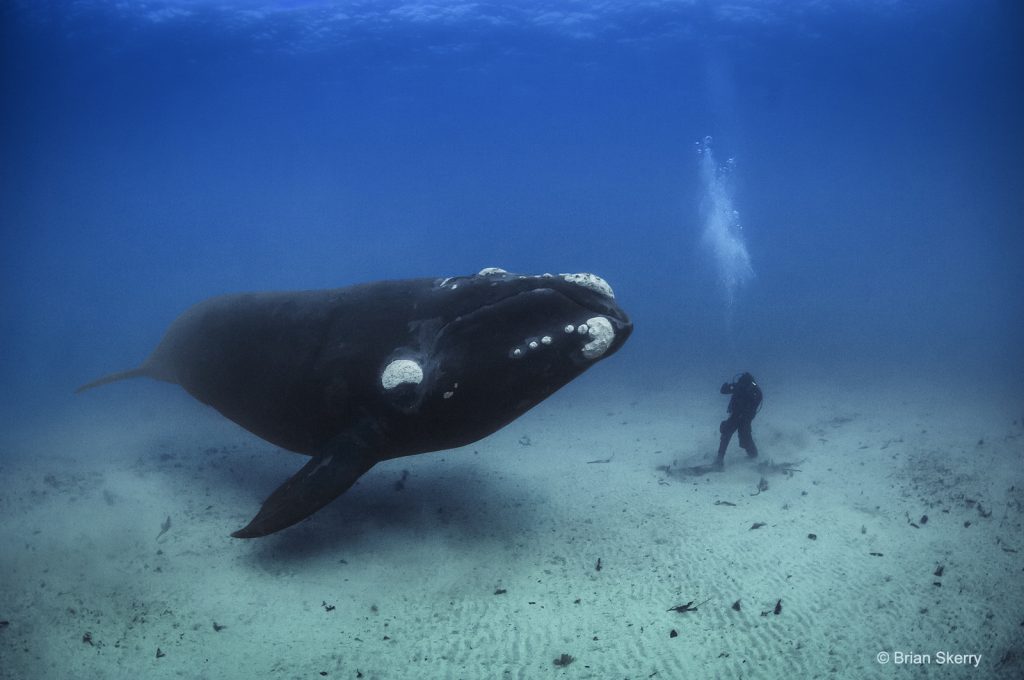
It sounds like you brought the scientists and researchers into the whole plan and collaborated with them closely.
Yes. It’s my job to put visuals to their research so it can reach a broader audience, raise awareness, and hopefully result in change.
I’m guessing when you are on location, you’re in the water all day, you’re working your butt off to get shots. Talk to me a little bit about being on location and what happens during your day-to-day work.
They are usually long days. You are up at 6 AM or whenever sunup might be. Here’s an example of a typical day in Dominica trying to photograph sperm whales.
For the last 15 years, Shane has worked in Dominica. He basically has identified a giant rectangle with GPS points on the leeward side of the island. Typically, he heads out on one of his boats to do his research.
The researchers go two or three miles off the coast from the harbor, stop the boat and then drop the hydrophones into the water to listen. They’re listening for either the echolocation clicks of a sperm whale or the socializing codas. If they don’t hear anything, they run maybe five miles to another GPS point and do the same thing. They basically do these grids throughout the day listening for whales.
Once they find the whales, they might use a directional hydrophone to figure out what direction they are in. And then slowly chug along and look for blows because the whales are down feeding for 45 minutes, come up for about 15 or 20 minutes and then go back down. So, if they catch them on the surface, they can find them and then follow them.
Of course, their hope is to identify which whales they are, and my hope is that they are going to stop at some point and come together in a social group so I can photograph them. It happens infrequently. So, we’re generally out in an inflatable boat. It’s a 30-foot rib, and we are doing this all day long. Even though it’s the leeward side of the island, it can be sloppy and rough. We’re getting sprayed all day long with waves breaking over us. And then we’re baking in the tropical sun. There’s no cover, there’s no Bimini top or anything, we’re just out there. I have to have my dive skin or wetsuit on from the time I get in the boat because if we see something I need to get in the water quickly. My camera’s right there. And sometimes there might be 10 other researchers on the boat.
And I’m guessing that you don’t always find the whales!
To give you some realities of what it’s like, that first year that I went on my first trip to Dominica, I was there for four weeks. And in four weeks I got one picture that I liked. That was it. It showed babysitting behavior and it was a really cool single picture. I decided that the next year I would go back to Dominica for five weeks and I did. But, for the first 19 days we didn’t see a single whale. Not a single whale.
OMG! You must have been freaking out!
Right? You spend every day on the boat and come back every night feeling dejected and depressed. I had spent a total of seven weeks in Dominica and only had one picture. Then Shane told me this had never happened before. Which, sadly, is not the first time I have heard this while in the field. So, that is the reality. Of course, I eventually did get into the water with sperm whales and was able to make some pictures, but it’s never easy.
I should note that all the work I was doing on Secrets of the Whales, with very few exceptions, was done free diving. So even when we saw a whale, I’d have two or three minutes to get underwater and get close. In my book, I talk about the Venn diagram of things that have to come together in order to get a photo.
Yes, I read that. There’s a whole lot of things that have to come together. The whales have to be there. There needs to be enough light. You need decent visibility. You’ve got to be close. They can’t reject you.
Yeah, all that. And ideally, they have to be doing something interesting. So, all of those things make it extraordinarily difficult to get pictures. That being said, I had a very ambitious shot list, and I think we got just about everything I wanted and more. We got these gems, these jewels that presented themselves. So, I think it was divine intervention for sure. We just got really lucky, and it worked out.
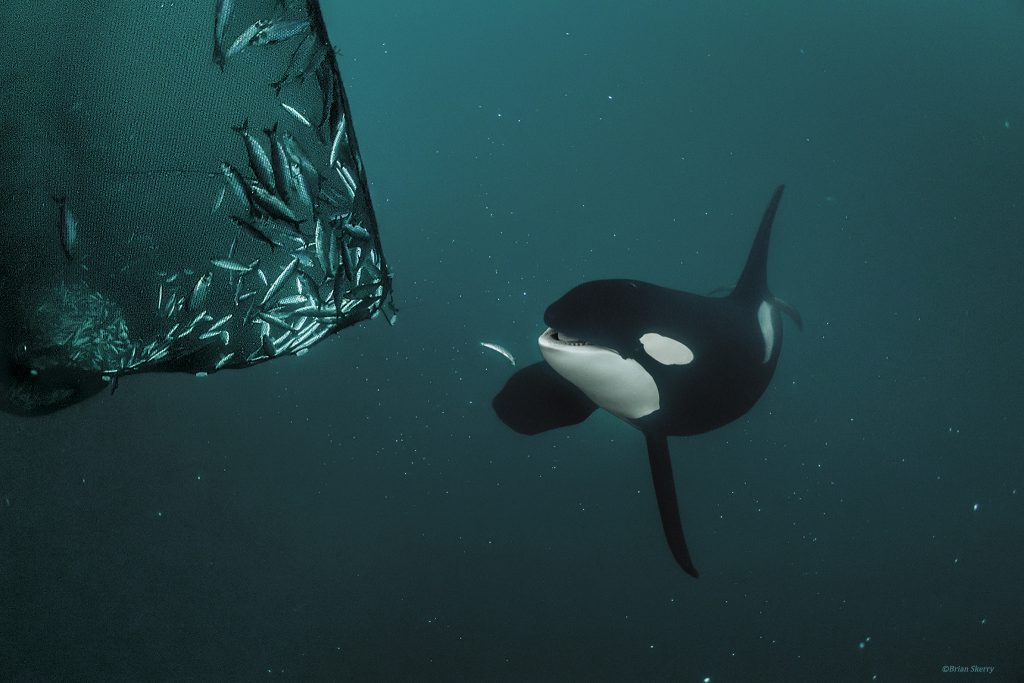
I am guessing that you’re always looking to complete your shot list, in addition to whatever surprises may happen.
Yes. I know ahead of time the kinds of pictures I want to make. But after decades of working in the ocean, you pick up a few things. You’re not only looking for the shot that you want, but you’re looking for things as they evolve with the animals underwater. You look for behaviors that might be beginning to form.
In terms of an onsite team, what would be typical? You have a couple people with you, in addition to the local people?
Yeah, usually. If it’s just a still photo magazine story, it’s me and one assistant, that’s it. And then I’m either working with a research team on their boats or I’m chartering my own boat. In most cases, with very few exceptions, I was working with researchers. And again, I can’t stress enough how valuable that is because, in a given place, they really know the most about these animals. And they also have a network of locals that let them know when they see a whale.
As opposed to you showing up by yourself and trying to figure out where the heck the whales are?
That would never happen. You wouldn’t get anywhere. So having good teams of people is key.
There are so many images that seem so intimate to me. I mean you’re just right there. How is it to work with those animals? What does it feel like being next to a big orca in the water? I imagine that would be a little frightening. Talk to me a little bit about the interaction part.
It is extraordinary. I’ve been very lucky to have so many wonderful wildlife encounters with all kinds of animals. But as I write in the book, there is something about whales that takes me to a rarefied plane. It’s a very different experience. Not only do they have to accept you and let you into their world, as I like to say, but with that big brain, they are cognitively processing you. We are not able to communicate, but it’s almost like, at times, there is this nonverbal communication.
In terms of interaction, it can go one of four ways. The whales might just swim away or they might allow you to be in their space but be indifferent to your presence. Then there are times when a whale might swim around you a little bit to check you out. Of course, the best is when a whale actually engages with you like the orca that dropped the stingray in front of me.
That was amazing! What was going through your mind at that moment?
What’s happening at that moment is that a big chunk of my brain is focused purely on the image. I’m seeing that scene unfold like a movie through my viewfinder. I’ve got the camera to my eye; I’m looking through the viewfinder. In some respects, I’m almost detached. But not really. My heart is racing, my mind is racing, I’m trying to figure out how to make that picture. When that orca female dropped that ray, it was one of the most extraordinary moments of my life, but she was backlit. The sun was directly behind her. So, I’ve got this black and white animal with a ray hanging out of her mouth and she swims around my back, stops in front of me, drops the ray, looks at me a few times and then picks up the ray. I’m thinking, “This is amazing. Wouldn’t it be great if the sun was actually shining on her?”
And that’s the way I often make a photo. I use the term “making” photos as opposed to taking photos. Because I think, like a filmmaker, a good photographer is looking at all four corners of that frame. What does the negative space look like? Where is the light? Not much I could do there except meter a little bit differently and try to make sure that I could pull out some of the shadows.
In the end, I got the photo. So, the process is as much about not screwing up as it is about analyzing, framing and lighting the scene to get the photo. I’m hypervigilant about exposures. When I’m swimming along I’m constantly checking my exposure. When the clouds obscure the sun, I change my aperture. I shoot everything on manual so I’m constantly changing my settings.
Of course, during that moment, there was also a part of my brain that was a 12-year-old boy saying, “I can’t believe I’m a meter or two away from a wild orca in New Zealand, and she’s got a stingray hanging out of her mouth! This is frigging awesome.” For me, I usually try to process those things later. However, my life has been on somewhat of a hamster wheel lately, where I’m just going from one thing to the next, to the next, so I don’t often get that time, the opportunity to process everything fully.
The project must have kept you very busy!
It did. For example, the trip to New Zealand in September 2019, was probably the shortest trip of any that I did for Secrets of the Whales. I started out that year spending time in Dominica, Sri Lanka, the Azores, six weeks in the Canadian Arctic, home for one day, then to New Zealand. From New Zealand I went to the Cook Islands. I’m traveling with 15 to 20 cases of equipment. I’m going from swimming with narwhals in 28°F water in the Arctic to swimming with humpbacks in the warm tropical waters of the Cook Islands. Then I’m on the computer at night checking on what’s going on at home and with the kids, with Marcia. But this last year with the pandemic, I have had time to think about stuff, a little bit.
I’m amazed by some of the unique images that you made, the discoveries; the nursing sperm whale, the grieving orca, the beluga games. It’s mind boggling. I can only imagine you watching this stuff happen in real time.
It’s unbelievable at times. You’re giddy inside, you’re trying to control your excitement because you don’t want to send out a vibe that scares the animal and you’re just praying that you get the picture. Then you’re back on the boat with a coat over your head, looking at the back of the camera and scrutinizing every little micro millimeter of the photos to be sure you didn’t screw something up.
Wow. And some of those are true discoveries, right? Like the nursing sperm whale. Scientists knew that baby sperm whales nursed, but it had never been witnessed before.
No. When we showed Shane the photos of the nursing calf that night, and my assistant was also shooting over my shoulder with video, he told us that there was an old saying in the whale biology world that goes, “Someday we’ll know everything there is to know about whales except how a sperm whale calf nurses.” They couldn’t figure it out. So, he texted a bunch of his colleagues, including his mentor, Doctor Hal Whitehead, and they were over the moon. They couldn’t believe it. Very cool stuff.
Were there any close calls or uncomfortable situations?
You know, I have to say no. It’s a legitimate question, but I never felt threatened. I never felt in any real danger. There were some long, cold days in rough seas on a little boat in the Norwegian Arctic while photographing orca, when I wondered if we would make it back to the dock. But certainly nothing from the animals.
I did have one interesting experience, not threatening in any way, that involves one of the things that the orca in Norway are doing more commonly these days. According to researchers, in recent times, orca have been hanging out next to fishing boats to get fish. This is called depredation. It’s an easy meal for them and could represent a shift in their culture.
I was out near a fishing boat one snowy, cold, gray day. They were towing their net full of herring at about half a knot or so and there were orca behind the boat, diving for and grabbing the fish that fell out of the net. I was freediving and the orca were sort of indifferent to me.
I realized that I needed to be down there at about 30 feet (9 meters), holding position, to get a really cool shot of the net with the orca coming in. So, I went back to my boat and I put on a little pony bottle. When I went back in the water, I noticed a change in the orcas’ behavior.
When I was just free diving, they didn’t pay any attention to me. But once I was down there holding position, you could see them change. It wasn’t threatening, but I got this vibe, as a whale was coming in to feed on the herring next to the net; it was kind of like, “Make no mistake, that’s mine. Don’t even think about coming near here!”
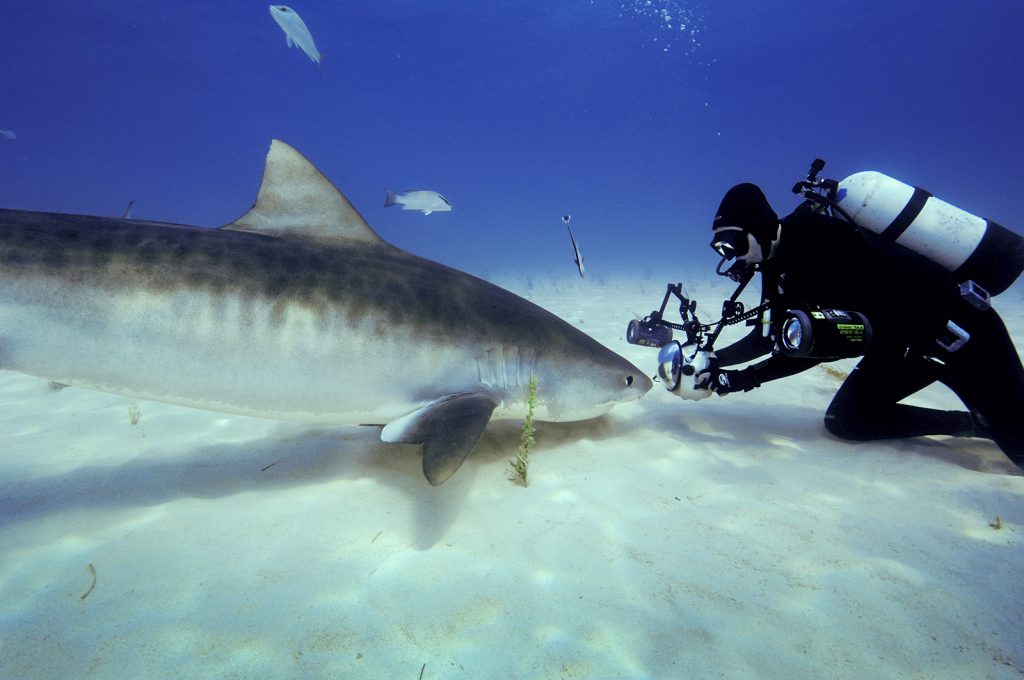
I was going to ask you about rebreathers. Obviously, scuba is loud but rebreathers make sounds, too, as the solenoid fires, for example. Do they not work so well with whales?
I think rebreathers can work well with whales. There are two reasons that I decided to go with free diving for this project. One is silence, for sure. Because the bubbles from scuba are distracting. But the other thing is just for nimbleness and mobility. Even with a group of socializing whales that are moving along slowly underwater, if I put on a rebreather that weighs 50 pounds, and a weight belt, I’m not going to really be able to keep up with them. I know there are guys who have had great success filming whales while using rebreathers, but for me the bang for the buck was going to be relatively minima,l and I just didn’t go there.
You mentioned the whales sleeping. I think there’s one picture of you just hanging in the blue with these whales. That must have just felt otherworldly.
It was, it really was. That’s a good description. Again, when I’m in those places, my mind is always racing about the photo. But there are those times where you just have to put the camera down or at your side and enjoy the moment.
So, when you’re out in the middle of that vastness of the blue ocean and you’re with a 45 or 50-foot animal (12-15 m), you feel so small. You’re humbled by the magnificence of this creature. And as you know, it’s a thinking creature with a big brain that’s making sense of you. With humpback whale calves or any calf, I might be the first human that they’ve ever seen, so I’m trying to make a good impression.
“With humpback whale calves or any calf, I might be the first human that they’ve ever seen, so I’m trying to make a good impression.”
But the experience of being out in that open blue for me is indescribable. I think for some people it might cause some sort of panic. But, for me, it perfectly defines this planet we live on better than anything. It’s this ocean planet and it’s vast and blue. And I love it.
You started with your focus on whale culture. What have you come away with, having now spent three years and thousands of hours underwater? What did you learn from that? Has your understanding changed as a result?
Yeah, such a great question. I would say a couple of things. First, the juxtaposition of me racing around the world for three solid years doing this project, and then coming to a hard stop as a result of COVID was, in my mind, no accident.
I did a separate project in March 2020 for National Geographic and Disney/ABC. It was a one-hour show that was supposed to be a live documentary for Earth Day, called Born Wild. We were going to do some of the segments in advance, but there would be live portions of it as well.
I went to Hawaii to work with humpback whales along with Flip Nicklin. We had to cut the trip short because of COVID. We were supposed to have six days on the ocean but got three before we had to return home. I went from traveling nine or ten months a year, some of those years, to not being near an airport since. I’ve been home for 15 months.
I have to say that being locked down during the pandemic with my family has given me time to reflect. My oldest daughter graduated university, and she was going to move to New York City, but had to wait. So, I was home with my wife, both daughters and the dog. I reflected a lot on my time with the whales. Especially since this was all supposed to be released in 2022 and it got moved up to 2021. As a result, I had to write the book sooner than planned as well.
Then, several months ago, I was invited to deliver the commencement speech at the university I graduated from in Massachusetts. The commencement speech sort of wrote itself. One of the themes that I worked into my speech was what I had learned from the whales. I realized it was less about learning something new; there was no revelation per se, but I had been reminded of things that I already knew. That family matters, that the community matters, that we need each other, that we are not able to survive alone as a species, that we are a social species in the same way that whales are.
I gave the example of sperm whales. These are animals that historically have been portrayed as monsters. Melville wrote about them in this way, although he had reverence for them. Yet we know today that these are the biggest brained animals on the planet and that they are shy, they are gentle, and they are highly social. Life in the ocean is tough and difficult for them. They might be some of the biggest, toughest guys out there, but every day they spend most of their lives in the deep ocean—600, 700, 800 meters deep—foraging for food, for squid. And they come up and they breathe for 20 minutes, and then they go back down.
But every day, or every couple of days, they make time to come together as a family. And they reaffirm those family and communal bonds. They rub against each other, they gently bite each other, they play, they roll around. And what I saw in their eyes and in their joyful collaboration could be described in no other way than bliss. So, they get it. Life is tough. But for an animal that spends all of its time in this deep, dark, cold, three-dimensional liquid void, those touching and tactile moments with each other are necessary and reaffirming.
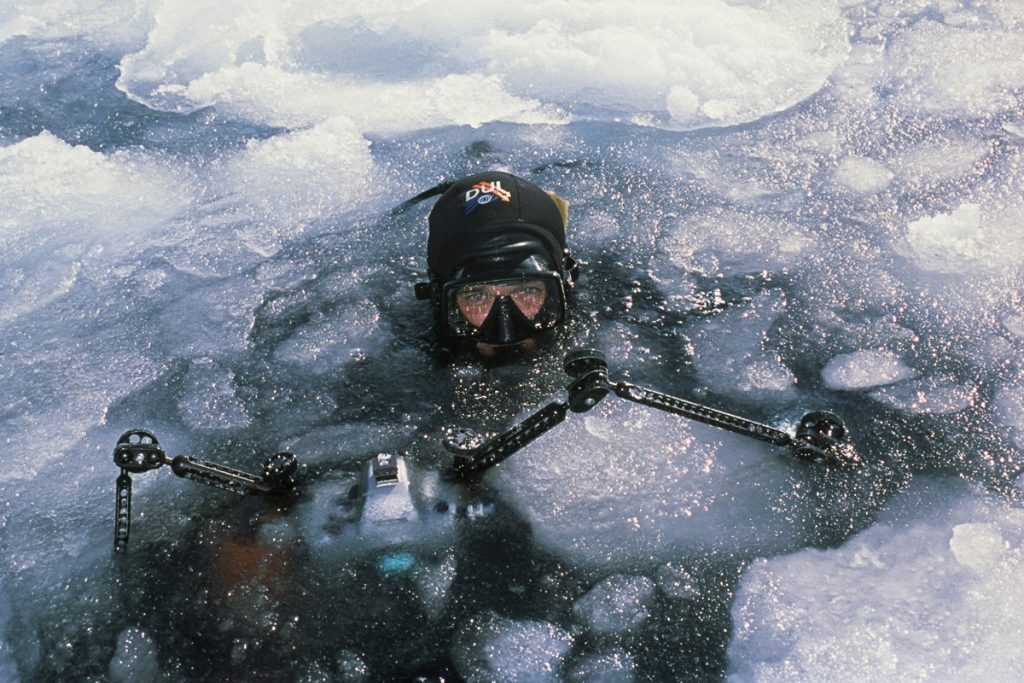
Similarly with the beluga whales in the Arctic, engaged in their gameplay. These are animals that spend the wintertime near Greenland where it’s dark 24 hours a day in the winter. Then as the sun begins to emerge in summer, they travel hundreds of miles through the Northwest passage and they come to this little remote island that I call their summer resort. It’s their “Beluga Beach.” Here they play, socialize and have their calves because the river is a few degrees warmer than the ocean water. And they exfoliate their skin on the gravel bottom.
They too have difficult lives. They have to find food and they have to look after their babies. Yet, they make time to pick up a pebble and swim around with it because it makes them happy.
So, what I told the graduates was this: you may not be able to control whether you get your dream job, you may not be able to totally control the trajectory of your career ambitions. But you can control the tapestry of your life, the threads that will create that beautiful picture when you’re older, by calling your parents or visiting a grandparent or having coffee with a friend, or meeting and talking to somebody on the bus. Those are the rich moments that you do have control over and will add such dimension and richness to your life in the end.
That’s beautiful, Brian. I’m tearing up.
I saw so much pain and suffering during the pandemic, and I saw people applauding the first responders in New York every night and I heard songs being played and saw musicians and artists coming together to celebrate community and to remind us of what we need. It was what I saw with the whales. They understood this already and they hadn’t forgotten it.
In my own life, over the last 23 years that I have worked for National Geographic, I have missed a lot. I’ve been away a lot, even though I tried to be there for all the big stuff. Even so, I missed piano recitals and soccer games, and a couple of birthdays here and there. You know, you can’t get those back. But you try to make it all count.
The whales reminded me of these things, that we as humans are not so different from them. We have culture and we have social needs. And it helps our brains to be in community with others.
Thank you for that Brian.
Header image details: Humpback whales work cooperatively to feed on herring by blowing a perfect ring of bubbles underwater that becomes a net or curtain of bubbles as it rises encircling the fish. The whales then swim upward through the center of the bubble net with their mouths open to feed. This behavior was first noted in the 1920’s by whalers. Scientists believe that this is a cultural behavior that started in Alaska and has been spread to other regions. The bubble-net feeding behavior in Alaska however is better understood and is described by researchers to have a social structure to it. There is a core group of approximately 60 humpbacks that engage in this behavior and certain groups of perhaps 8-14 whales tend to work together frequently. New technology, such as aerial video from drones, is allowing for a far better understanding of these social structures. It is believed that each whale performs a specific task, such as blowing the bubble net while another whale vocalizes to further aggregate the fish.
Dive Deeper:
Disney+: Secrets of The Whales
InDepth: Can We Learn to Talk with Whales? Introducing Project CETI
Amazon.com: Brian Skerry in books
IMPACT: The Conservation Photography Podcast— Diving into Secrets of the Whales: An Interview with Brian Skerry
Time: How Whales Can Teach Us to Be Better Humans by Brian Skerry
Kansas Public Radio, Conversations: The Secrets of Whales
CNN: National Geographic photographer on discovering the secrets of whales
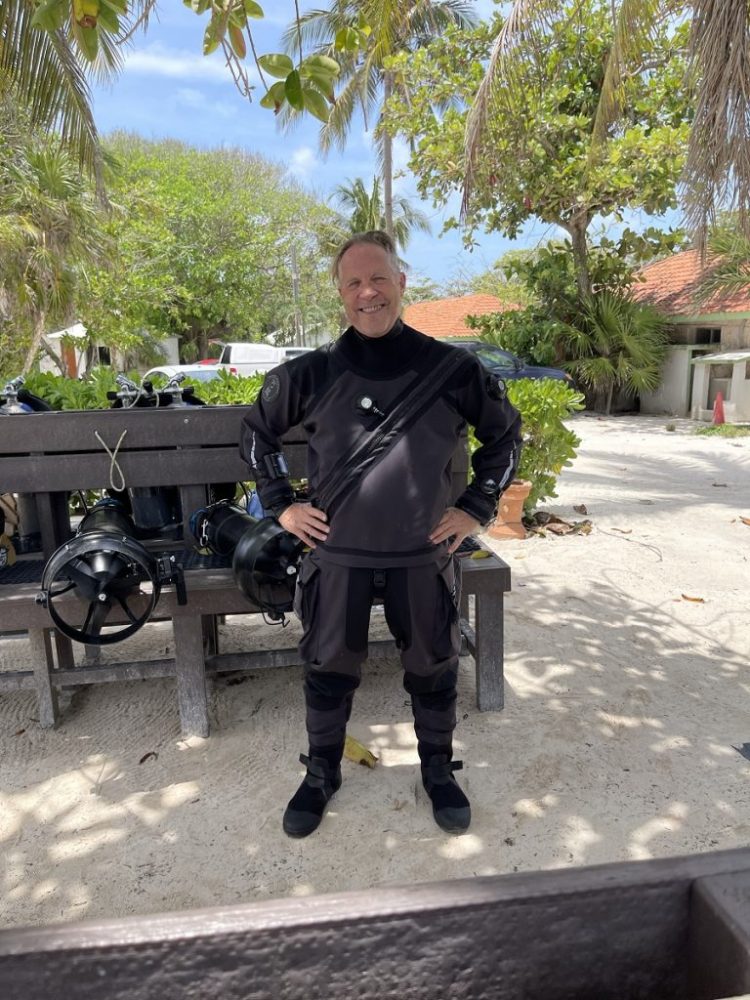
Michael Menduno/M2 is InDepth’s editor-in-chief and an award-winning journalist and technologist who has written about diving and diving technology for more than 30 years. He coined the term “technical diving.” His magazine “aquaCORPS: The Journal for Technical Diving” (1990-1996), helped usher tech diving into mainstream sports diving, and he produced the first tek.Conferences and Rebreather Forums 1.0 & 2.0. In addition to InDepth, Menduno serves as an editor/reporter for DAN Europe’s Alert Diver magazine, a contributing editor for X-Ray mag, and writes for DeeperBlue.com. He is on the board of the Historical Diving Society (USA), and a member of the Rebreather Training Council.


















